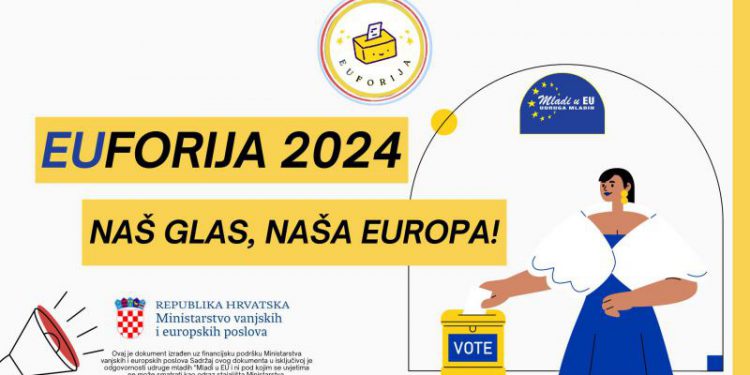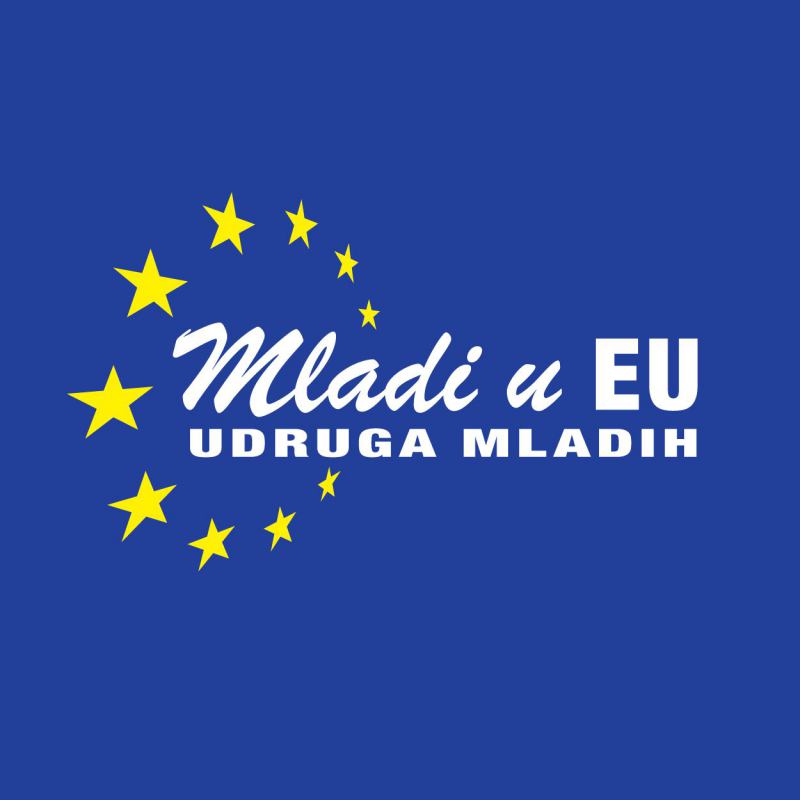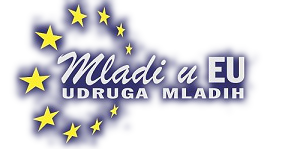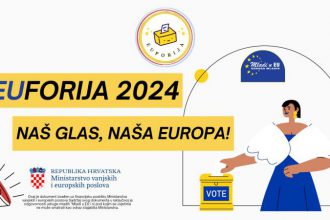Institucije EU – Europska komisija i Vijeće Europske unije | EUforija 2024: Naš Glas, Naša Europa | Ministarstvo vanjskih i europskih poslova

(HR)
U prethodnom dijelu objasnili smo kako Europski parlament funkcionira i njegove funkcije, a sada ćemo isto napraviti za Europsku komisiju i Vijeće Europske unije. Europske institucije se u nekim točkama isprepliću i razumjet ćemo do koje mjere. Zapamtite da je vaš glas za Parlament važan i utječe na ostale institucije. Jeste li spremni otkriti više?
Glavna uloga Europske komisije je promicanje općih interesa Europske unije, osiguravanje primjene zakonodavstva, te provedba politika i proračuna EU-a. Komisija je osnovana 1958. godine, kao progresija visoke vlasti Europske zajednice za ugljen i čelik (ECSC) kako se Unija razvijala.
Smještena u Bruxellesu, Europska komisija je politički neovisno izvršno tijelo EU-a. Također je odgovorna za izradu prijedloga za novo zakonodavstvo i provedbu odluka donesenih u Parlamentu i Vijeću EU-a.
Za razliku od Parlamenta, predsjednik i skupština povjerenika odobrava Parlament, što znači da ih građani ne biraju izravno, ali o tome ćemo kasnije. Što Komisija radi?
- štiti interese Unije i njezinih građana
- postavlja prioritete trošenja
- izrađuje proračun EU-a za odobrenje Parlamentu i Vijeću
- sudjeluje s Europskim sudom u osiguravanju pravilne primjene zakona
- pregovara i govori u ime svih zemalja EU-a u međunarodnim tijelima
Što se tiče sastava, važno je naglasiti da svaki povjerenik odgovara svakoj državi članici, što znači da trenutno postoji 27 povjerenika, svaki zadužen za određeno područje djelovanja. Na primjer, sadašnja hrvatska povjerenica, Dubravka Šuica, zadužena je za područje demografije i demokracije.
Kako se bira predsjednik Europske komisije i odobrava njegov tim? Sve se vraća na Europski parlament, uz pomoć Europskog vijeća (objasnit ću razliku između svih ovih vijeća kada dođemo do Vijeća Europske unije). Pojednostavljeno, uzimajući u obzir rezultate europskih izbora, Europsko vijeće predlaže kandidata, a zatim tog kandidata mora prihvatiti većina zastupnika u Europskom parlamentu kako bi bio izabran.
Kandidat za predsjednika bira potpredsjednike i povjerenike, uzimajući u obzir prijedloge svake zemlje EU-a. Popis zatim mora odobriti nacionalni čelnici u Europskom vijeću. Nakon toga, Parlament glasuje o prihvaćanju ili odbijanju kandidata kao tima. Konačna odluka opet pada na Europsko vijeće koje imenuje tim Komisije kvalificiranom većinom, što znači da predstavnici 15 od 27 država članica moraju odobriti tim.
Sada prelazimo na Vijeće Europske unije, posljednje europsko tijelo koje ćemo obraditi, ali ne manje važno. Također osnovano 1958. godine, prvo pod imenom Vijeće Europske ekonomske zajednice, Vijeće EU je glas vlada država članica Unije i ima za cilj donošenje zakona EU-a i koordinaciju politika.
Evo zabavnog dijela! Postoje još dva vijeća koja možete zamijeniti s ovim: Europsko vijeće i Vijeće Europe.
- Europsko vijeće je summit koji se održava svaka četiri mjeseca, na kojem se okupljaju čelnici EU-a kako bi postavili smjernice za kreiranje politika.
- Vijeće Europe NIJE institucija EU-a, što znači da je potpuno nepovezano. To je međunarodna organizacija sa sjedištem u Strasbourgu (Francuska) posvećena zaštiti ljudskih prava, demokracije i vladavine prava.
Vijeće Europske unije, s druge strane, mjesto je gdje se ministri vlada svake države članice sastaju kako bi raspravljali, izmijenili i donijeli zakone ili koordinirali politike EU-a. Na tim sastancima, ministri imaju moć obvezati vlade svojih zemalja na dogovorene akcije. To znači da je, uz Europski parlament, ovo tijelo jedno od glavnih institucija za donošenje odluka Europske unije.
Njegove odgovornosti su:
- pregovaranje i usvajanje zakona EU-a, zajedno s Parlamentom, na temelju prijedloga Komisije.
- koordinacija politika država članica EU-a
- razvijanje zajedničke vanjske i sigurnosne politike prema smjernicama Europskog vijeća
- sklapanje međunarodnih sporazuma između EU-a i drugih dionika
- usvajanje godišnjeg proračuna, naravno, uz suradnju Europskog parlamenta
Međutim, tko su članovi Vijeća? Vijeće Europske unije nema stalne članove, što znači da se sastaje prema području politike. Zamislite da se Vijeće sastaje o financijskim pitanjima, prisustvovat će mu ministar financija svake zemlje.
Osim vanjskih poslova koji imaju stalnog predsjedatelja (visoki predstavnik EU za vanjske poslove i sigurnosnu politiku), svim sastancima predsjedava relevantni ministar zemlje koja ima predsjedništvo EU-a.
Sada se možda pitate, a što je predsjedništvo EU-a? Tijekom razdoblja od šest mjeseci, jedna od zemalja EU-a vodi Vijeće, postavljajući zajednički cilj koji traje 18 mjeseci, osiguravajući kontinuitet rada. Trenutno smo pod belgijskim predsjedanjem, a sljedeća će biti Mađarska.
Sada kada su europske institucije demistificirane, ne zaboravite da sve ovisi o vašem glasu kako biste mogli ostvariti promjenu!
Ne zaboravite glasati 9. lipnja! Naš glas, naša Europa!
(EN)
What are the EU institutions pt.2?
Previously, we tackled the way that the European Parliament is and its functions and now we are going to see the same for the European Commission and the Council of the European Union. The European Institutions tangle in some points and we will understand a bit more to what extent. Remember that your vote for the Parliament is important and will also influence the other institutions. Are you ready to discover more?
The European Commission has its main role the promotion of the general interests of the European Union and making sure the legislation is applied, and also implementing policies and the EU budget. The commission was established in 1958, this institution was created in a progression of the high authority of the European Community of Steel and Coal (ECSC) as the Union evolved.
Located in Brussels, the European Commission is EU’s politically independent executive arm. It is also responsible for building proposals for new legislation and implement the decisions made both in the Parliament as in the Council of the EU.
Differently from the parliament, the President and the assemble of commissioners is approved by the parliament, this meaning that is not elected directly by the citizens, but we will come back to this later on.
So what does the Commission do?
- protects the interests of the Union and its citizens
- sets the spending priorities
- elaborates the EU’s budget to be sent for approval to the Parliament and Council
- with the Court of Justice ensures that laws are applied properly
- negotiates and speaks on behalf of all EU countries with/in international bodies.
Regarding the composition let me just highlight that each commissioner corresponds to each member-state, meaning that the team of commissioners is currently 27, each assigned to a designated field of action. For example, the current Croatian commissioner, Dubravka Šuica, is assigned the policy area of Demography and Democracy.
How does the President of the European commission gets elected and its team approved? It all goes back to the European Parliament, with the assistance of the European Council (I will explain when we arrive to the Council the European Union the difference between all these Councils). Simplifying it would be, taking in account the results of the European Elections, a candidate is suggested by the European Council, after that this candidate needs to be accepted by the majority of the MEPs in order to be elected.
The candidate to be President chooses Vice-Presidents and Commissioners keeping in mind suggestions from each EU country. Then the list has to be approved by the national leaders in the European Council. Afterwards, the Parliament votes on accepting or rejecting the nominees as a team. Finally, the last decision lands again with the European Council as it appoints the Commission’s team by a qualified majority, meaning that representatives of 15 of the 27 Member-States need to approve it.
Moving on now to the Council of the European Union, the last European body we are going to approach, but not less important. Also established in 1958, firstly with the name of Council of the European Economic Community, the Council of the EU is the voice of the governments of the Member States of the Union, and has, as well, the goal of adopting EU laws and coordinating the policy.
Here is the fun part! There are two more councils that you can mistake as this one: The European Council and the Council of Europe.
- The European Council is a summit that happens every four months, in which the EU leaders gather to set the trend of the policy making.
- The Council of Europe is NOT an EU institution at all, meaning it’s completely unrelated. It is an international organisation based in Strasbourg (France) that protects human rights, democracy and the rule of law.
The Council of the European Union, in its turn, is where the government ministers of each Member-State meet to discuss, amend and adopt laws, or coordinate EU policies. In these meetings, the ministers have the power to commit their countries’ governments to actions that are agreed. This translates that, along with the European Parliament, this body is one of the main decision-making institutions of the European Union.
Its responsibilities are:
- negotiating and adopting EU laws, hand-in-hand with the Parliament, based on Commission’s proposals.
- coordinating the EU Member-States’ policies
- developing, according to the European Council guidelines, a common foreign and security policy
- concluding international agreements between the EU and other stakeholders
- adopting the annual budget, of course, with the collaboration of the European Parliament
However, who are the members of the Council? The Council of the European Union does not have fixed members, this means that when meeting they meet according to policy area. Imagine if the Council is meeting on financial matters it will be attended by the finance minister of each country.
Besides Foreign Affairs that has a permanent chairperson (the EU High Representative for Foreign Affairs and Security Policy), all meetings are led by the relevant minister of the country that has the EU presidency.
Now you might ask, what is the EU presidency? During a period of six months one of the EU countries gets to be leading the Council, setting a common goal that lasts for 18 months, guaranteeing that there is a work of continuity. Currently, we are under the Belgian presidency and following will be Hungarian.
Now that the European Union institutions are demystified, don’t forget that it all goes down to your vote to be able to assert a change!
Don’t forget to go vote on the 9th of June! Our Vote, Our Europe!
Ovaj je dokument izrađen uz financijsku podršku Ministarstva vanjskih i europskih poslova Sadržaj ovog dokumenta u isključivoj je odgovornosti udruge mladih “Mladi u EU i ni pod kojim se uvjetima ne može smatrati kao odraz stajališta Ministarstva.
This document was created with the financial support of the Croatian Ministry of Foreign and European Affairs. The content of this document is the sole responsibility of the youth association “Youth in the EU” and can in no way be taken to reflect the views of the Ministry.
 |
 |
 |
 |
Author/Autor: Ana Antónia Alves Fernandes

